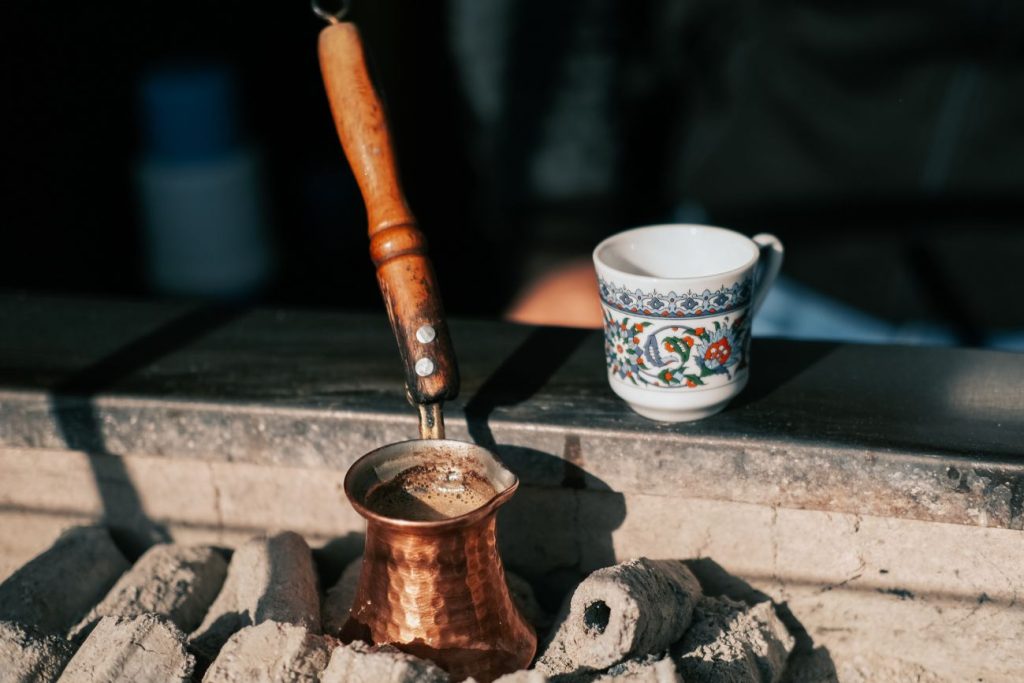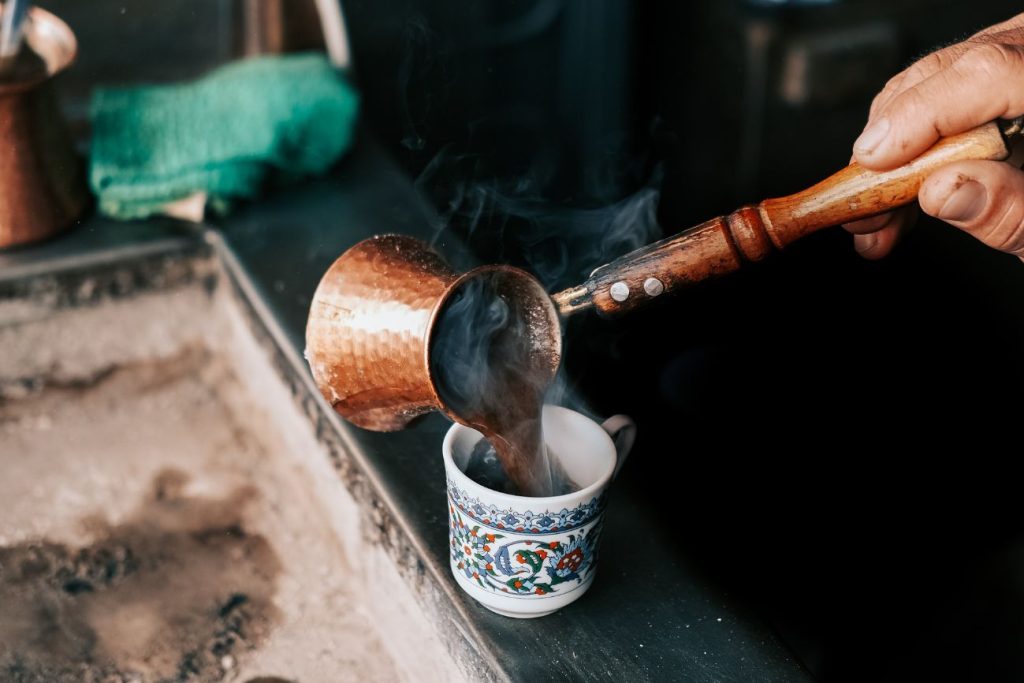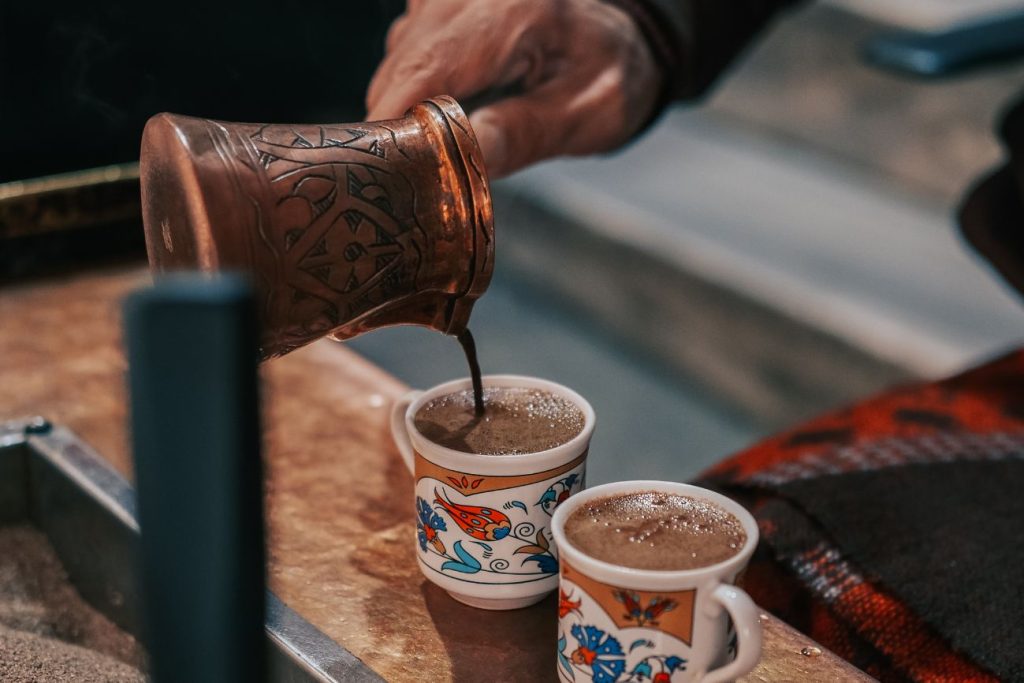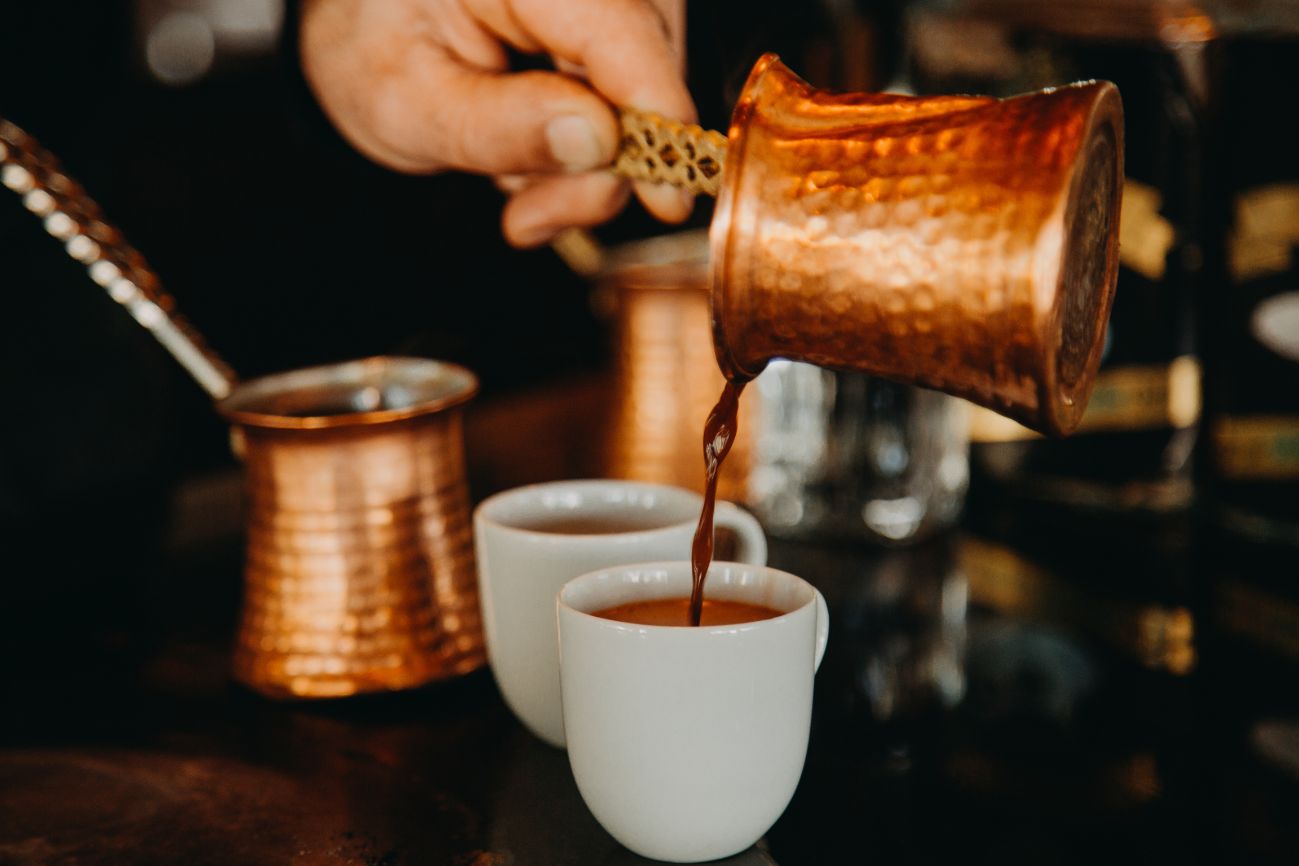If you’ve ever heard the term “Turkish coffee” or watched a Turkish serial, you’ll want to know what it is, how it’s brewed, and what the advantages and drawbacks are.
Here’s a simple breakdown of all your questions about Turkish coffee.
Turkish Coffee Basics
Turkish coffee is more than simply coffee; it is a ritual and tradition that developed in Middle Eastern and European countries such as Turkey, Iran, and Greece. The Turkish coffee brewing method is considered the earliest coffee brewing method because it originated in the early 16th century during the Ottoman Empire. Turkish coffee is more than simply a beverage; it is a lifestyle and tradition that is well-known for its brewing and serving methods.
Brewing Method
When we talk about its brewing procedure, that is the key reason why this coffee has become a ritual that is deeply rooted in Turkey’s cultural history.
To make Turkish coffee, extremely finely ground beans are used, similar to a fine floor, and the coffee is brewed in a copper pot known as a cezve.
After removing the extra fine ground coffee beans, they are mixed with water and boiled over low heat in cezve. The coffee is heated until a foamy and frothy layer forms on top of it, known as the characteristic foam, just below the boiling point.
After brewing, the coffee is left unfiltered and served as it is. The coffee grinds settle at the bottom of the pot, and the remaining coffee is served.
If you ever have the opportunity to have Turkish coffee, you will notice that there may be small coffee grounds in the bottom of your cup.
The entire brewing process produces a rich and strong coffee flavor.
Turkish coffee can be consumed without sugar, however it is typically served with a moderate amount of sugar.
The Origins of Turkish Coffee
Ethiopian Roots
According to historical records and myths, coffee was initially discovered in Ethiopia. It is stated that a goat herder named Kaldi discovered that his goats were energized after eating some weird berries. When he realized this, he tried these berries on his own and noticed the same result.
According to some myths, he took these beans to Islamic monks, but they refused to accept the reality. They throw these beans on fire, but when they recognize the delicious aroma, they gather the roasted beans and discover the first coffee cup by grinding and diluting it with water.
Some research indicates that coffee was introduced in 575. According to some, the term “coffee” comes from the Arabic word “kahva,” which means wine, while others believe it came from Kaffa, a place in southwestern Ethiopia. We cannot be certain about these myths and research.
Yemeni Sufi Connection
Coffee was introduced to Yemen in the early 15th century, primarily among Sufi monks. Yemenis were the first coffee drinkers, to use it as a hot beverage to stay active and awake. Sufi monks, old Sufi practitioners, used to sip coffee to keep awake during their nighttime vigils and nightly prayers.
However, when a 1762 Danish scientific expedition visited Yemen, he discovered that Yemenis disliked coffee brewed in the “Turkish” style. Other scientists, such as John Ellis, and other visitors noted the same thing.
They observed that Yemenis preferred kisher, a beverage produced from coffee shells that tasted more like tea.
They only consume kishar, a beverage brewed from dried hulls, in huge numbers and raise coffee for export. Yemen became a center for coffee growing and trading.

Ottoman Adoption
1. Introduction to Istanbul
Coffee was first introduced into the Ottoman Empire in the 16th century. According to historical records, the Ottoman governor of Yemen, Özdemir Pasha, brought it to Sultan Suleiman the Magnificent’s court.
2. Cultural Integration
Turkish people refined the brewing method, using a cezve (ibrik) to boil finely ground coffee with water (and optional sugar), creating a strong, unfiltered beverage. They began brewing coffee in copper pots, which resulted in wonderful and rich coffee flavors. This method became central to Turkish social life. Following that, this creamy, rich beverage became a symbol of hospitality and refinement.
3. Coffeehouses and Social Impact
Alternatively, Syrian traders Hakam and Shams may have established the first coffeehouse, “kahvehane,” in Istanbul in about 1554 to promote Turkish coffee to the public. These locations eventually became landmarks where people met to appreciate poetry, play games like chess and backgammon, and debate philosophical issues. Turkish coffee has since become an integral element of both their daily lives and ceremonial events.
Spread to Europe
Turkish coffee was not only limited to the Ottoman Empire or Istanbul, but it expanded throughout Europe, most likely starting in Venice where it was drunk as a medication. Early consumers included travelers who imported for their own use, as well as gentleman-scholars who were intrigued about the outside world and eager to experience foreign items. After that, this unique beverage spread to cities such as Venice, Paris, and London in the 17th century. In 1645, the first coffeehouse in Venice opened, inspired by the Ottoman kahvehane.
However, European coffee facilities do not consume it as is; instead, they tweak the taste by adding sugar and other spices to suit local tastes.
Following that, these changes laid the way for many modern coffee styles, such as espresso and filter coffee.
However, the rich essence of Turkish coffee, a thick, unfiltered brew with a distinctive froth remains central to worldwide coffee culture.
Many other regions have adapted Turkish coffee over time, with minor differences in preparation and presentation. And then it’s called “Greek coffee” in Greece, “Armenian coffee” in Armenia, “Bosnian coffee” in Bosnia and Herzegovina, and so on.
Cultural Legacy
Turkish coffee is more than just coffee; it has become a symbol of hospitality, with customs such as serving it to guests and utilizing the grounds for fortune-telling (tasseography). It has become a traditional drink, extensively consumed at all functions and social gatherings.
It became a part of their wedding ceremonies and a sign of hospitality and friendship.
Recognized by UNESCO in 2013 as part of Turkey’s Intangible Cultural Heritage, it remains a cherished tradition.
A Marriage Tradition
Rather than simply a coffee Beverage Turkish coffee has become a part of their marriage ceremony. In Turkish tradition, when the groom and his family come to the bride’s home for the marriage proposal, the bride prepares coffee for his family. At this moment, the groom has to pass a patience, tolerance, and a sense of humor test. Bride-to-be will intentionally prepare a separate cup of coffee for the boy with salt instead of sugar. She can add more salt or a small amount. If the groom drinks the coffee without any anger or unpleasant expressions, the bride-to-be considers that the groom is kind and patient.
The groom must pass this patience test to show his good nature and good temper. This symbolizes hospitality and connection, transforming a simple gesture into a significant tradition that draws families closer together.

Which Factors Make Turkish Coffee Unique?
Extremely Fine Grind Size
In traditional Turkish coffee, a powdery fine grind size is used to prepare coffee. When you touch it, you will sense a fine, powered-like consistency. This is an extensively finer grind size than we use in espresso and drip coffees. This finer consistency completely dissolves in water, giving the coffee a rich and robust taste.
Brewing Technique
The Turkish coffee brewing method is unique and traditional. It is brewed in a copper pot, a traditional pot known as cezve. When brewed over low heat, the coffee infuses deeply, producing a rich, full-bodied cup. If you are brewing the coffee yourself, you must keep the temperature below boiling point to preserve the natural aroma and taste. There are modern Turkish coffee makers on the market that provide the same authentic experience while also being more convenient.
Rich and Foamy Texture
The rich, thick, and creamy texture of this coffee is what makes it so popular around the world. The fine powder grind size, slow brewing procedure, and unfiltered servings contribute to its deep and potent flavor. The oil and solids are removed with coffee grounds, in other coffee methods that use filters. However, because Turkish coffee is not filtered, all of its flavorful components remain untouched, resulting in a thicker, richer, more velvety, and full-bodied experience. The natural foam that forms on top of the coffee gives it a traditional look.
This foamy top adds a creamy layer to the coffee, allowing it to stay warmer longer. In Turkish culture, the foamy texture of a cup of coffee represents tradition, culture, and a sign of respect for your guest.
Built-in Sweetness
Like in other coffee methods, we add sugar to the coffee after it has been brewed. However, with Turkish coffee, sugar is added during the brewing process, resulting in an extremely blended sweetness that blends seamlessly with the robust tastes. You can choose the sugar content you want, but there will be no stirring after brewing.
Served Unfiltered
As previously explained, traditional Turkish coffee brewing uses an extremely fine grind size, such as powder. Turkish coffee is served unfiltered, which means that the fine coffee grounds settle at the bottom of the cup. This unfiltered process is meant to preserve the oils, natural flavors, and aroma of coffee.
Small Cup Serving Tradition
Turkish coffee is traditionally served in little cups known as fincans. These little cups are beautifully decorated, adding to the symbolic appeal of drinking Turkish coffee. The modest size of the cups ensures that the coffee stays warm and that there is just enough coffee to enjoy slowly and calmly.
Turkish Coffee: Really Good For Your Health or Just a Tradition
If we talk about it, is it beneficial to drink Turkish coffee or is it just a tradition or a culture? So undoubtedly, this provides a lot of health benefits, which are the following:
Enhance Athletic Performance
As you know, Turkish coffee is brewed with a fine grind size over slow heat, resulting in a higher caffeine concentration than other modern coffee processes. Caffeine is known as a natural energy enhancer that can help to improve your athletic performance. According to a study, athletes who drink caffeinated Turkish coffee have significantly better performance than those who drink decaffeinated coffee.
Improve Inflammation and Blood Sugar Levels
As you know, Turkish coffee is served unfiltered, thus it contains more healthy ingredients than other coffees. Coffee beans naturally contain chlorogenic acids, which are polyphenol antioxidants with health benefits. As a result of the fine ground size, Turkish coffee had more chlorogenic acids than coffee brewed with coarser grounds. Studies have revealed that chlorogenic acids can help with inflammation, blood sugar, cholesterol, and high blood pressure. Coffee also includes strong components like diterpenoids, which can help you reduce inflammation, fight infection, and improve your heart health.
Protect Your Brain
Caffeine can help protect your brain from certain neurological diseases, including Alzheimer’s disease. Turkish coffee has a higher caffeine level, which can help protect your brain from many neurological problems. According to studies including over 29,000 adults, those who drank the most coffee had a 27% decreased risk of developing Alzheimer’s disease.
Reduce the Risk of Type 2 Diabetes
Other benefits of drinking Turkish coffee include a lower risk of certain diseases such as diabetes and heart disease. According to studies, drinking one cup of coffee each day reduces your chance of developing type 2 diabetes by 7%. Another study found that drinking 3 to 5 cups of coffee daily reduced heart disease risk by 15%.
Cardamom Provides Further Health Benefits
As you know, Turkish coffee is usually brewed with cardamom, which provides numerous health benefits. It contains potent antioxidants that can help reduce inflammation, lowering your risk of chronic diseases. Cardamom also helps us fight cancer and has antibacterial properties.

Downside of Turkish Coffee Which No One Will Tells You
Despite its health benefits, Turkish coffee also has several disadvantages. As you know, Turkish coffee has added sugar, thus consuming it daily can lead to obesity, high triglyceride levels, and type 2 diabetes. To prevent these diseases, drink Turkish coffee without sugar and add spices like cardamom to make it naturally enjoyable.
Furthermore, the higher caffeine concentration of Turkish coffee can be dangerous for persons who are sensitive to caffeine. Drinking caffeinated coffee can cause sleep problems, anxiety, and other negative effects. High caffeine concentration raises blood pressure, therefore you should avoid it if you have high blood pressure.
This unfiltered coffee contains cafestol, a diterpenoid that can elevate blood cholesterol and triglyceride levels.
Is Turkish Coffee Stronger Than Espresso?
When it comes to “Strength” in coffee can refer to caffeine content (total caffeine per serving or per millilitre) or to flavour concentration (how bold or intense the cup tastes). Comparing Turkish coffee and espresso involves looking at both aspects.
Caffeine Concentration
- Espresso: A standard 1 ounce (30 ml) shot of espresso contains on average about 64 mg of caffeine, (Super Coffee says roughly 2.1 mg per ml).
- Turkish Coffee: A typical demitasse (60 ml) of Turkish coffee delivers about 50–65 mg of caffeine (CAFELY says that is about 0.8–1.25 mg per ml).
Espresso has a higher caffeine content per ounce. However, a full serving of Turkish coffee contains a similar or even higher total caffeine content as below. It is served unfiltered and brewed with a fine grind size, which allows more coffee solids to remain in the cup.
Caffeine per Serving
- Espresso (single shot): ~63 mg per 30 ml (from OutIn)
- Turkish Coffee: ~50–65 mg per 60 ml (from CAFELY)
However, if you drink a double‑shot espresso (around 125 mg) will exceed the caffeine in a standard Turkish brew.
Flavor and Texture
- Espresso: Produced under high pressure, espresso yields a thick, concentrated shot topped with crema and a bold, intense flavour profile.
- Turkish Coffee: Brewed by boiling extra‑fine grounds without filtration, Turkish coffee retains suspended particles and oils, creating a heavy‑bodied cup with pronounced texture and a uniquely rich, lingering taste.
So, while both brews pack a punch, espresso reigns supreme in strength per sip, whereas Turkish coffee offers a similarly robust caffeine hit in a slightly larger, sediment‑rich format.

How To Make Turkish Coffee at Home?
After reading about its culture, traditions, and benefits, you’ll undoubtedly want to enjoy a cup of Turkish coffee, so here’s a quick and easy Turkish coffee recipe.
Ingredients
- Water (5 to 6 Ounces)
- 2 Tbsp of finely ground coffee beans just like powder
- Sugar (optional)
- Traditional Cezve or any other pot you have
Brewing Method
- Take your pot and add coffee grounds, water, and sugar in it.
- Mix well to dissolve the coffee and sugar in water.
- Now turn the stove on a medium flame and place the pot or cezve on it.
- Just before the boiling point the coffee will rise and a foamy texture will appear on top.
- Don’t bring a boil, just remove the cezve and let it sit for a minute.
- Now Pour slowly in the Traditional cups and enjoy.
Conclusion
Now that you know the history, brewing method, and cultural significance of Turkish coffee, you can truly appreciate why it’s more than just a drink, it’s an experience. Whether you see it as a cherished tradition, a strong caffeine fix, or a fascinating ritual, Turkish coffee has left its mark on the world in a way few other brews have.
If you ever get the chance to try it, pay attention to the rich foam, the deep aroma, and the way it brings people together. And if you’re feeling adventurous, maybe even try your luck at reading your coffee grounds. Who knows? You might just uncover your future in the bottom of your cup.




